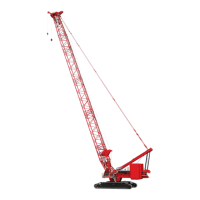HOISTS MLC165-1 SERVICE/MAINTENANCE MANUAL
5-52
Published 05-26-17, Control # 238-02
WIRE ROPE INSPECTION AND
REPLACEMENT
The following information is from various wire rope
manufacturers and includes inspection, replacement, and
maintenance guidelines for wire rope as established by
ANSI/ASME B30.5, federal regulations, and Manitowoc
Cranes.
Wire Rope Lubrication
Refer to the Lubrication Guide in this manual for
recommendations.
Maintain a Wire Rope Condition Report
Always keep on file a signed and dated periodic inspection
report of the wire rope’s condition. The report must cover all
inspection points discussed in this section. The information
in the reports can then be used to determine when a wire
rope should be replaced.
After initial loading of a new rope, measure and record its
diameter for comparison with future inspections. Measure
the rope’s diameter across the crowns of the strands so the
true diameter is measured as shown in Figure 5-36 on
page 5-55.
Wire rope removed from service should be examined and a
corresponding report kept. This information can be used to
establish a relationship between visual inspection and the
rope’s actual internal condition at the time of its removal from
service. See Replacement Criteria
on page 5-54 for
inspection guidelines.
Required Inspection Intervals
The frequency of wire rope inspection should be:
• Daily (see Daily Inspection
on page 5-53)
and, at minimum:
• Yearly (see Periodic Comprehensive Inspection
on
page 5-54)
Wire Rope Care and Replacement Guidelines
1. When replacing fixed-length wire rope assemblies (such
as pendants) having permanently attached end fittings,
use only pre-assembled lengths of wire rope as supplied
from Manitowoc Cranes. Do not build lengths from
individual components.
2. Replace an entire wire rope assembly. Do not attempt to
rework damaged wire rope or wire rope ends.
3. Never electroplate wire rope assemblies.
4. Do not weld any wire rope assembly or component
unless welding is recommended by the wire rope
manufacturer.
Welding spatter must never be allowed to come in
contact with the wire rope or wire rope ends. In addition,
be sure that the wire rope is not an electrical path during
other welding operations.
5. Wire ropes are manufactured from special steels. If
heating a wire rope assembly is absolutely necessary for
removal, the entire wire rope assembly must be
discarded.
6. On systems equipped with two or more wire rope
assemblies operating as a matched set, they must be
replaced as an entire set.
7. Do not paint or coat wire ropes with any substance
except approved lubricants.

